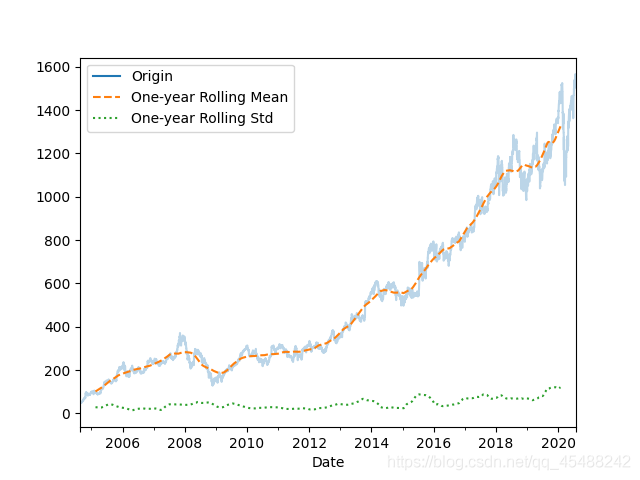13.Pandas處理時間序列
文章目錄
Pandas處理時間序列
Pandas最初是爲了處理金融模型而建立的,因此Pandas具有一些非常強大的日期,時間,帶時間索引數據的處理工具
本章將介紹的日期和時間數據主要包含三類:
- 時間戳:時間戳表示某個具體的時間點,例如2020年7月30日晚上10點41分
- 時間間隔與週期:時間間隔值兩個時間戳之間的時間長度,週期是具有相同長度,彼此不重疊的特殊的時間間隔
- 時間增量或持續時間:表示精確的時間間隔,例如一個程式的執行時間是24秒
下面 下麪將介紹Pandas中的三種日期 / 時間數據型別的具體用法
Python的日期與時間工具
在講解Pandas的日期與時間工具之前首先講解下Python的原生的日期和時間工具(包括除了Pandas之外的第三方庫)
儘管Pandas提供的時間序列工具更加適合處理數據科學問題,但是瞭解Python標準庫和其他時間序列工具將會大有裨益
原生Python的日期與時間工具:datetime與dateutil
Python原生的基本的日期和時間功能都在datetime標準庫的datetime模組中,我們可以和第三方庫dateutil結合就可以快速實現許多處理日期和時間的功能
建立日期
我們可以使用datetime模組中的datetime物件建立一個日期
from datetime import datetime
datetime_1=datetime(year=2020,month=7,day=30)
print(datetime_1)
>>>
2020-07-30 00:00:00
或者我們可以使用dateutil庫的parser模組來對字串格式的日期進行解析(但是隻能用英美日期格式),使用parse函數解析將會得到一個datetime物件
from dateutil import parser
datetime_1=parser.parse('30th of July, 2020')
datetime_2=parser.parse('July 30th,2020')
print(datetime_1)
print(datetime_2)
>>>
2020-07-30 00:00:00
2020-07-30 00:00:00
指定輸出
一旦我們具有了一個datetime物件,我們就可以通過datetime物件的strftime方法來指定輸出的日期格式
from datetime import datetime
from dateutil import parser
datetime_1=parser.parse('30th of July, 2020')
print(datetime_1.strftime('%A'))
>>>
Thursday
這裏我們通過標準字串格式%A來指定輸出當前datetime物件的星期
實際上Python的datetime和dateutil物件模組在靈活性和易用性上的表現非常出色,但是就像前面不斷提起的,使用Python原生的datetime物件處理時間資訊在面對大型數據集的時候效能沒有Numpy中經過編碼的日期型別陣列效能好
Numpy的日期與時間工具:datetime64型別
Numpy團隊爲了解決Python原生陣列的效能弱點開發了自己的時間序列型別,datetime64型別將日期編碼爲64位元整數,這樣能夠讓日期陣列非常緊湊,從而節省記憶體.
Numpy建立日期陣列
我們在建立Numpy的日期陣列時,只需要指定數據型別爲np.datetime64即可建立日期陣列
date_1=np.array('2020-07-30',dtype=np.datetime64)
print(date_1)
print(type(date_1))
print(date_1.dtype)
>>>
2020-07-30
<class 'numpy.ndarray'>
datetime64[D]
Numpy日期陣列的運算
Numpy陣列的廣播規則,對於日期陣列也是成立的,只不過此時計算轉變爲日期之間的計算
date_1=np.array('2020-07-01',dtype=np.datetime64)
print(date_1)
print(date_1+np.arange(start=1,stop=12,step=1))
>>>
2020-07-01
['2020-07-02' '2020-07-03' '2020-07-04' '2020-07-05' '2020-07-06'
'2020-07-07' '2020-07-08' '2020-07-09' '2020-07-10' '2020-07-11'
'2020-07-12']
正式因爲Numpy處理日期時將日期陣列進行了編碼(編碼爲datetime64),而且支援廣播運算,因此在處理大型數據的時候將會很快
Numpy的datetime64物件
前面講過,Numpy可以用日期陣列來表示日期
其實也可以使用datetim64物件來表示,即使用64位元精度來表示一個日期,這就使得datetime64物件最大可以表示264的基本時間單位
datetime64物件的建立
date_1=np.datetime64('2020-07-01')
print(date_1)
print(type(date_1))
>>>
2020-07-01
<class 'numpy.datetime64'>
datetime64物件的單位
datetime64物件所以如果我們指定日期的單位是納秒的話,就能表示0~264納秒的時間跨度
注意,日期的單位在沒有指定的時候將會按照給定的日期來自動匹配,例如
date_1=np.datetime64('2020-07-01') //自動匹配日期單位爲天
date_2=np.datetime64('2020-07-01 12:00') //自動匹配日期單位爲分鐘
date_3=np.datetime64('2020-07-01 12:00:00.500000000') //自動匹配日期單位爲納秒
此外,我們也可以指定日期單位
date_1=np.datetime64('2020-07-01','ns')
指定日期時間單位的程式碼爲
| 程式碼 | 含義 | 時間跨度 |
|---|---|---|
| Y | 年 | -9.2e18~9.2e18年 |
| M | 月 | -7.6e17~7.6e17年 |
| W | 周 | -1.7e17~1.7e17年 |
| D | 日 | -2.5e16~2.5e16年 |
| h | 時 | -1.0e15~1.0e15年 |
| m | 分 | -1.7e13~1.7e13年 |
| s | 秒 | -2.9e12~2.9e12年 |
| ms | 毫秒 | -2.9e9~2.9e9年 |
| us | 微秒 | -2.9e6~2.9e6年 |
| ns | 納秒 | -292~292年 |
| ps | 皮秒 | -106天~106天 |
| fs | 飛秒 | -2.6小時-2.6小時 |
| as | 原秒 | -9.2秒~9.2秒 |
其中日期的零點是按照1970年1月1日0點0分0秒來計算的
最後,雖然Numpy的datetime64物件彌補了Python原生的datetime物件的不足,但是卻缺少了許多datetime,尤其是dateutil原本便捷的方法和函數,爲此,解決日期和時間相關內容的最佳工具就是Pandas
Pandas的日期和時間工具
Pandas所有的日期和時間處理方法全部都是通過Timestamp物件實現的
Timestamp物件有機的結合了np.datetime64物件的有效儲存和向量化介面將datetime和dateutil的易用性
建立Timestamp物件
我們可以使用to_datetime函數來建立一個Timestamp物件
Timestamp_1=pd.to_datetime('2020-07-01')
print(Timestamp_1)
print(type(Timestamp_1))
>>>
2020-07-01 00:00:00
<class 'pandas._libs.tslibs.timestamps.Timestamp'>
呼叫datetime和dateutil的方法
我們可以直接將Timestamp物件視爲datetime物件,然後直接呼叫dateutil和datetime中的方法
Timestamp_1=pd.to_datetime('2020-07-01')
print(Timestamp_1)
print(Timestamp_1.strftime('%A'))
>>>
2020-07-01 00:00:00
Wednesday
最後,Pandas通過一組Timestamp物件就可以建立一個能夠作爲DataFrame物件或者Index物件索引的DatetimeIndex物件
就像前面在講解Pandas數據透視表的泰坦尼克號的例子中就已經有所展現
DatetimeIndex物件不僅僅具有Index物件的功能和特性,同時還具有用於日期處理的屬性和方法
Pandas的時間序列:以時間作爲索引
Pandas的時間序列攻擊非常適合用於處理以時間戳爲索引的數據
建立時間序列索引
和Index物件的建立類似,我們只需要直接建立即可
DateTimeIndex_1=pd.DatetimeIndex(['2020-07-01','2020-07-02','2020-07-03'])
print(DateTimeIndex_1)
print(type(DateTimeIndex_1))
>>>
DatetimeIndex(['2020-07-01', '2020-07-02', '2020-07-03'], dtype='datetime64[ns]', freq=None)
<class 'pandas.core.indexes.datetimes.DatetimeIndex'>
指定時間序列爲索引
和我們前面爲Series和DataFrame物件指定索引一樣,我們也指定DatetimeIndex物件爲索引
DateTimeIndex_1=pd.DatetimeIndex(['2020-07-01','2020-07-02','2020-07-03'])
Series_1=pd.Series(np.random.randint(0,10,3),index=DateTimeIndex_1)
DataFrame_1=pd.DataFrame(np.random.randint(0,10,(3,4)),columns=list('ABCD'),index=DateTimeIndex_1)
print(Series_1)
print(DataFrame_1)
>>>
2020-07-01 8
2020-07-02 4
2020-07-03 3
dtype: int64
A B C D
2020-07-01 8 1 7 0
2020-07-02 9 0 2 1
2020-07-03 9 6 3 2
從上面的兩個例子中我們不難看出,Pandas對於時間序列的處理非常的強大,下面 下麪就將講解Pandas中針對不同時間資訊給出的不同的物件
Pandas的時間序列物件
本節將介紹Pandas中用來處理時間序列的不同的物件
- 針對時間戳數據,Pandas提供了Timestamp物件,就像前面介紹的一樣,Timestamp是Python原生的datetime類的替代品,但是是基於效能更好的datetime64物件構建的.對應的以時間戳爲索引的就是DatetimeIndex物件
- 針對時間週期數據,Pandas提供了Period物件.同樣,Period物件也是基於datetime64物件將固定頻率的時間間隔進行編碼,對應的以週期爲爲索引的物件是PeriodIndex物件
- 針對時間增量或持續時間,Pandas提供了Timedelta類.Timedelta類是代替Python原生的datetime.timedelta類的高效能物件.同樣Timedelta類是基於numpy的timedelta64物件.以Timedelta爲索引的物件是TimedeltaIndex
前面已經講解過了Pandas的Timestamp物件的建立和DatetimeIndex物件的建立,下面 下麪將講解Pandas中常用的to_datetime()函數
to_datetime()函數
Pandas的to_datetime()函數可以解析許多的日期與時間格式,例如Python原生的datetime類,英美日期時間格式等等
而且根據傳入的值的不同,將會返回不同的物件,如果僅僅傳遞一個值,那麼將會返回Timestamp物件,如果傳遞多個時間值,將會返回一個DatetimeIndex物件
datetime_1=datetime(year=2020,month=7,day=31)
day_1='4th of July,2020'
day_2='20200731'
day_3='31-07-2020'
Timestamp_1=pd.to_datetime(datetime_1)
Timestamp_2=pd.to_datetime(day_1)
Timestamp_3=pd.to_datetime(day_2)
Timestamp_4=pd.to_datetime(day_3)
Timestamp_5=pd.to_datetime([Timestamp_1,Timestamp_2,Timestamp_3,Timestamp_4])
print(Timestamp_1,'\t',type(Timestamp_1))
print(Timestamp_2,'\t',type(Timestamp_2))
print(Timestamp_3,'\t',type(Timestamp_3))
print(Timestamp_4,'\t',type(Timestamp_4))
print(Timestamp_5,'\t',type(Timestamp_5))
>>>
2020-07-31 00:00:00 <class 'pandas._libs.tslibs.timestamps.Timestamp'>
2020-07-04 00:00:00 <class 'pandas._libs.tslibs.timestamps.Timestamp'>
2020-07-31 00:00:00 <class 'pandas._libs.tslibs.timestamps.Timestamp'>
2020-07-31 00:00:00 <class 'pandas._libs.tslibs.timestamps.Timestamp'>
DatetimeIndex(['2020-07-31', '2020-07-04', '2020-07-31', '2020-07-31'], dtype='datetime64[ns]', freq=None) <class 'pandas.core.indexes.datetimes.DatetimeIndex'>
to_period()方法
注意,上面使用to_datetime()方法得到的DatetimeIndex物件的數據型別是datetime64[ns],
我們如果想要改變其中每一個值的編碼方式,來擴大表示範圍的話,可以呼叫DatetimeIndex物件的to_period()方法來指定
datetime_1=datetime(year=2020,month=7,day=31)
day_1='4th of July,2020'
day_2='20200731'
day_3=pd.Timestamp('31-07-2020')
DatetimeIndex_1=pd.to_datetime([datetime_1,day_1,day_2,day_3])
print(DatetimeIndex_1)
print(DatetimeIndex_1.to_period('D'),'\t',type(DatetimeIndex_1.to_period('D')))
>>>
DatetimeIndex(['2020-07-31', '2020-07-04', '2020-07-31', '2020-07-31'], dtype='datetime64[ns]', freq=None)
PeriodIndex(['2020-07-31', '2020-07-04', '2020-07-31', '2020-07-31'], dtype='period[D]', freq='D') <class 'pandas.core.indexes.period.PeriodIndex'>
此外,當一個日期減去另外一個日期的時候,將會返回Timedelta物件
datetime_1=datetime(year=2020,month=7,day=1)
day_1='2th of July,2020'
day_2='20200703'
day_3=pd.Timestamp('07-04-2020')
DatetimeIndex_1=pd.to_datetime([datetime_1,day_1,day_2,day_3])
print(DatetimeIndex_1)
print(DatetimeIndex_1-DatetimeIndex_1[0],'\t',type(DatetimeIndex_1-DatetimeIndex_1[0]))
>>>
DatetimeIndex(['2020-07-01', '2020-07-02', '2020-07-03', '2020-07-04'], dtype='datetime64[ns]', freq=None)
TimedeltaIndex(['0 days', '1 days', '2 days', '3 days'], dtype='timedelta64[ns]', freq=None) <class 'pandas.core.indexes.timedeltas.TimedeltaIndex'>
date_range()函數
爲了能夠便捷的建立有規律的時間序列,Pandas提供了一些方法:
- pd.date_range()可以處理時間戳
- pd.period_range()可以處理週期
- pd.timedelta_rang()可以處理時間間隔
類似於np.arange()函數,pd.date_range()函數通過開始日期,結束日期和頻率程式碼來建立一個序列
Date_1=pd.date_range(start='20200701',end='20200712',freq='D')
Date_2=pd.date_range(start='20200701 12:00',end='20200701 20:00',freq='H')
print(Date_1)
print(Date_2)
>>>
DatetimeIndex(['2020-07-01', '2020-07-02', '2020-07-03', '2020-07-04',
'2020-07-05', '2020-07-06', '2020-07-07', '2020-07-08',
'2020-07-09', '2020-07-10', '2020-07-11', '2020-07-12'],
dtype='datetime64[ns]', freq='D')
DatetimeIndex(['2020-07-01 12:00:00', '2020-07-01 13:00:00',
'2020-07-01 14:00:00', '2020-07-01 15:00:00',
'2020-07-01 16:00:00', '2020-07-01 17:00:00',
'2020-07-01 18:00:00', '2020-07-01 19:00:00',
'2020-07-01 20:00:00'],
dtype='datetime64[ns]', freq='H')
此外,我們也可以不指定結束日期,僅指定開始日期和週期數以及頻率程式碼來建立一個時間序列
Date_1=pd.date_range(start='20200701',periods=8,freq='D')
Date_2=pd.date_range(start='20200701 12:00',periods=8,freq='H')
print(Date_1)
print(Date_2)
>>>
DatetimeIndex(['2020-07-01', '2020-07-02', '2020-07-03', '2020-07-04',
'2020-07-05', '2020-07-06', '2020-07-07', '2020-07-08'],
dtype='datetime64[ns]', freq='D')
DatetimeIndex(['2020-07-01 12:00:00', '2020-07-01 13:00:00',
'2020-07-01 14:00:00', '2020-07-01 15:00:00',
'2020-07-01 16:00:00', '2020-07-01 17:00:00',
'2020-07-01 18:00:00', '2020-07-01 19:00:00'],
dtype='datetime64[ns]', freq='H')
period_range()與timedelta_range()函數
我們如果要建立有規律的週期或者時間間隔序列,可以使用period_range()或者timedelta_range()函數
Date_1=pd.period_range(start='20200701',periods=8,freq='D')
Date_2=pd.timedelta_range(start='20200701',periods=8,freq='D')
print(Date_1)
print(Date_2)
>>>
PeriodIndex(['2020-07-01', '2020-07-02', '2020-07-03', '2020-07-04',
'2020-07-05', '2020-07-06', '2020-07-07', '2020-07-08'],
dtype='period[D]', freq='D')
TimedeltaIndex(['0 days 00:00:00.020200', '1 days 00:00:00.020200',
'2 days 00:00:00.020200', '3 days 00:00:00.020200',
'4 days 00:00:00.020200', '5 days 00:00:00.020200',
'6 days 00:00:00.020200', '7 days 00:00:00.020200'],
dtype='timedelta64[ns]', freq='D')
Pandas時間頻率與偏移量
前面介紹的種種便捷生成時間序列的函數,我們都可以指定freq參數來指定生成的每個時間之間的間隔
實際上我們也可以組合各種時間頻率來達到我們預期的時間間隔
首先給出所有freq參數支援的時間頻率程式碼
| 程式碼 | 描述 |
|---|---|
| D | 天 |
| W | 周 |
| M | 月末 |
| Q | 季末 |
| A | 年末 |
| H | 小時 |
| T | 分鐘 |
| S | 秒 |
| L | 毫秒 |
| U | 微秒 |
| N | 納秒 |
| B | 天,僅含工作日 |
| BM | 月末,僅含工作日 |
| BQ | 季末,僅含工作日 |
| BA | 年末,僅含工作日 |
| BH | 工作時間 |
| MS | 月初 |
| BMS | 月初,僅含工作日 |
| QS | 季初 |
| BQS | 季初,僅含工作日 |
| AS | 年初 |
| BAS | 年初,僅含工作日 |
此外,我們還可以在頻率程式碼後面加上三位月份縮寫,來指定開始時間
例如: Q-JAN,BQ-FEB,AS-MAR
我們也可以將頻率組合起來來建立新的週期
例如: 2H30T
Date_1=pd.date_range('20200701 8:00',periods=3,freq='QS-Apr')
Date_2=pd.date_range('20200701 8:00',periods=3,freq='2H30T')
Date_3=pd.date_range('20200701 8:00',periods=3,freq='1D2H30T')
print(Date_1)
print(Date_2)
print(Date_3)
>>>
DatetimeIndex(['2020-07-01 08:00:00', '2020-10-01 08:00:00',
'2021-01-01 08:00:00'],
dtype='datetime64[ns]', freq='QS-APR')
DatetimeIndex(['2020-07-01 08:00:00', '2020-07-01 10:30:00',
'2020-07-01 13:00:00'],
dtype='datetime64[ns]', freq='150T')
DatetimeIndex(['2020-07-01 08:00:00', '2020-07-02 10:30:00',
'2020-07-03 13:00:00'],
dtype='datetime64[ns]', freq='1590T')
Pandas的重新取樣,遷移和視窗
下面 下麪將結合Google股價的歷史變化來講解Pandas的重新取樣,遷移和視窗
獲取Google的股價數據
pandas-datareader是一個基於Pandas的程式包,它可以從一些可靠的數據來源獲取金融數據,包括Yahoo財經,Google財經即其他數據源
但是由於pandas-datareader中從Yahoo財經下載數據的Python指令碼中出現了問題,因此往往會下載到錯誤的數據,所以我們還需要下載fix-yahoo-finance庫來修復這個問題
import pandas_datareader.data as web
import yfinance as yf
import datetime
yf.pdr_override()
google=web.get_data_yahoo('GOOGL',start='2004-08-19',end='2020-07-31',data_source='google')
print(google.head())
print(type(google))
>>>
[*********************100%***********************] 1 of 1 completed
Open High Low Close Adj Close Volume
Date
2004-08-19 50.050049 52.082081 48.028027 50.220219 50.220219 44659000
2004-08-20 50.555557 54.594593 50.300301 54.209209 54.209209 22834300
2004-08-23 55.430431 56.796795 54.579578 54.754753 54.754753 18256100
2004-08-24 55.675674 55.855854 51.836838 52.487488 52.487488 15247300
2004-08-25 52.532532 54.054054 51.991993 53.053055 53.053055 9188600
<class 'pandas.core.frame.DataFrame'>
由於我們每次執行都是現場從網上爬取數據,因此速度會比較慢,我們不妨先呼叫DataFrame物件的to_csv()方法將爬取到的數據儲存在當前檔案路徑下,然後後面要用只需要呼叫即可,但是每次新讀取之後都需要首先把索引改變爲DatetimeIndex物件
import numpy as np
import pandas as pd
import matplotlib.pyplot as plt
import pandas_datareader.data as web
import yfinance as yf
import datetime
yf.pdr_override()
google=web.get_data_yahoo('GOOGL',start='2004-08-19',end='2020-07-31',data_source='google')
google.to_csv('GoogleStock.csv')
接下來就我們就將取其中的收盤價(擷取DataFrame物件的列會返回一個Series物件),呼叫Series物件的plot方法來繪圖
import numpy as np
import pandas as pd
import matplotlib.pyplot as plt
import pandas_datareader.data as web
import yfinance as yf
import datetime
yf.pdr_override()
google=web.get_data_yahoo('GOOGL',start='2004-08-19',end='2020-07-31',data_source='google')
print(google.head())
print(type(google))
google['Close'].plot()
plt.xlabel('Date')
plt.ylabel('Price')
plt.title('Price of the GOOGLE Stock')
plt.show()
>>>
[*********************100%***********************] 1 of 1 completed
Open High Low Close Adj Close Volume
Date
2004-08-19 50.050049 52.082081 48.028027 50.220219 50.220219 44659000
2004-08-20 50.555557 54.594593 50.300301 54.209209 54.209209 22834300
2004-08-23 55.430431 56.796795 54.579578 54.754753 54.754753 18256100
2004-08-24 55.675674 55.855854 51.836838 52.487488 52.487488 15247300
2004-08-25 52.532532 54.054054 51.991993 53.053055 53.053055 9188600
<class 'pandas.core.frame.DataFrame'>
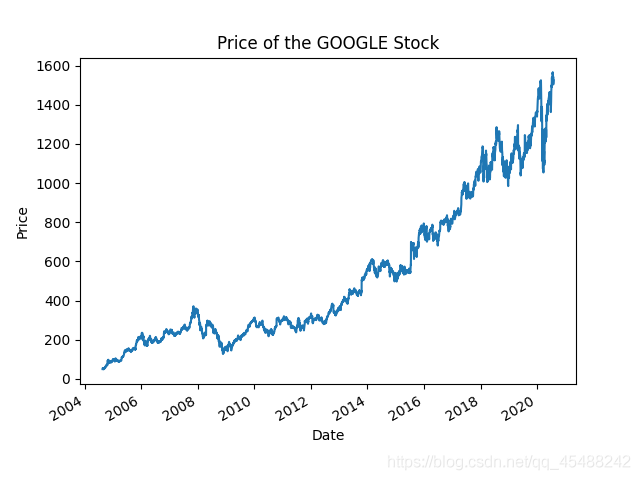
重新取樣與頻率轉換
我們在處理時間序列數據的時候,經常需要按照新的頻率來對數據進行重新取樣.例如上面我的Google股價是以天爲頻率的,我們如果想以月爲頻率的話,就需要每隔一個月進行重新取樣
對於重新取樣,我們可以呼叫resample()方法還活着asfreq()方法來完成,但是resample方法是以數據累計爲基礎,即我們對月進行重取樣的結果是一個月的所有值的和,我們需要手動求平均;而asfreq()方法則是以數據選擇爲基礎,即選取上個月的最後一個值
下面 下麪我們將使用兩種方法對數據進行向後採樣(down-sample),這裏不是降採樣,而是向後採樣
google=pd.read_csv('GoogleStock.csv')
DatetimeIndex_1=pd.to_datetime(google['Date'])
google.index=DatetimeIndex_1
del google['Date']
google_close=google['Close']
google_close.plot(alpha=0.5,style='g-')
google_close.resample('BA').mean().plot(style='b:')
google_close.asfreq('BA').plot(style='r--')
plt.legend(['Original Curve','Resample Curve','Asfreq Curve'],loc='upper left')
plt.xlabel('Date')
plt.ylabel('Price')
plt.title('Price of the GOOGLE Stock')
plt.show()
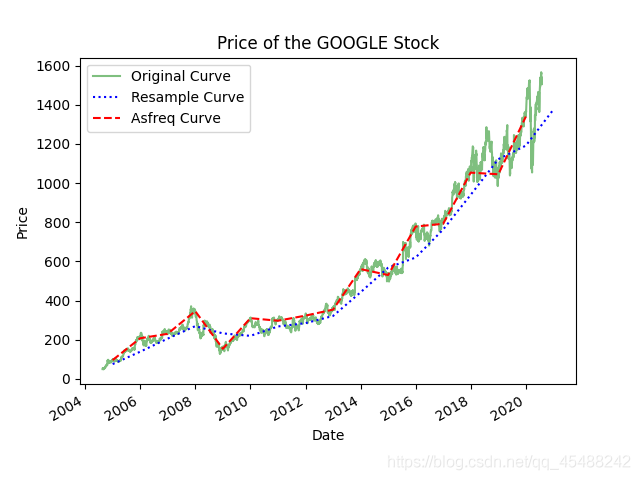
接下來我們再進行向前取樣(up-sample)由於向前取樣時會出現缺失值,所以asfreq()方法中有一個參數method來指定填充缺失值的方法
下面 下麪我們對工作日數據按天進行重取樣,然後比較向前和向後填充,這裏我們用到了在matplotlib中將會講解的ax等內容.
google=pd.read_csv('GoogleStock.csv')
DatetimeIndex_1=pd.to_datetime(google['Date'])
google.index=DatetimeIndex_1
del google['Date']
google_close=google['Close']
fig, ax=plt.subplots(2,sharex=True)
data=google_close.iloc[:10]
data.asfreq('D').plot(ax=ax[0],marker='o')
data.asfreq('D',method='bfill').plot(ax=ax[1],style='-o')
data.asfreq('D',method='ffill').plot(ax=ax[1],style='--o')
ax[1].legend(['Back-fill','Forward-fill'])
plt.show()
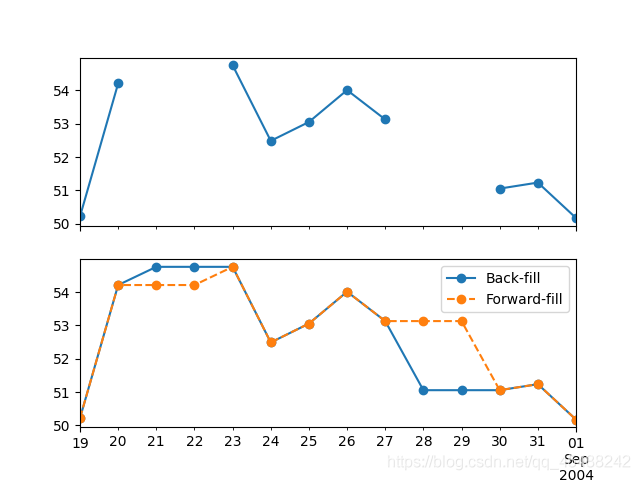
時間遷移
Pandas中另外一種常用的時間序列操作就是時間遷移,時間遷移指的就是將數據對應的時間進行改變
Pandas中有兩種解決時間遷移問題的方法:shift()和tshitf()方法
shift()方法是對數據進行遷移,而tshift是對索引進行遷移
google=pd.read_csv('GoogleStock.csv')
DatetimeIndex_1=pd.to_datetime(google['Date'])
google.index=DatetimeIndex_1
del google['Date']
google_close=google['Close']
fig, ax=plt.subplots(3,sharex=True)
google_close=google_close.asfreq('D',method='pad') #去除缺失值的影響
google_close.plot(ax=ax[0])
google_close.shift(900).plot(ax=ax[1])
google_close.shift(900).plot(ax=ax[2])
local_max=pd.to_datetime('2007-11-05')
offset=pd.Timedelta(900,'D')
ax[0].legend(['Original Curve'],loc=2)
ax[0].get_xticklabels()[4].set(weight='heavy',color='red')
ax[0].axvline(local_max,alpha=0.3,color='red')
ax[1].legend(['Shift(900)'],loc=2)
ax[1].get_xticklabels()[4].set(weight='heavy',color='red')
ax[1].axvline(local_max+offset,alpha=0.3,color='red')
ax[2].legend(['Tshift(900)'],loc=2)
ax[2].get_xticklabels()[1].set(weight='heavy',color='red')
ax[2].axvline(local_max+offset,alpha=0.3,color='red')
plt.show()
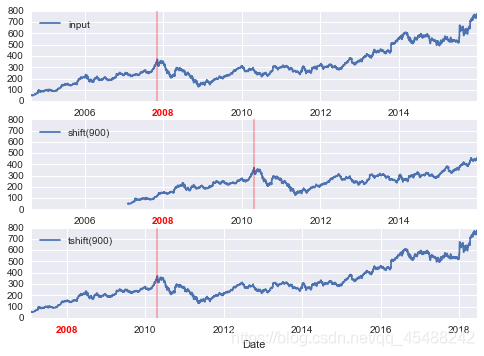
移動時間視窗
Pandas處理時間序列的第三種操作是移動統計值,計算移動統計值可以通過Series或者DataFrame物件的rolling()方法來實現
rolling()方法將會返回與groupby操作類似的結果
google=pd.read_csv('GoogleStock.csv')
DatetimeIndex_1=pd.to_datetime(google['Date'])
google.index=DatetimeIndex_1
del google['Date']
google_close=google['Close']
google_close=google_close.asfreq('D',method='pad')
rolling=google_close.rolling(365,center=True)
data=pd.DataFrame({'Origin':google_close,'One-year Rolling Mean':rolling.mean(),'One-year Rolling Std':rolling.std()})
ax=data.plot(style=['-','--',':'])
ax.lines[0].set_alpha(0.3)
plt.show()
